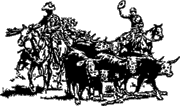|
The original Longhorn cattle were brought to North America over 500 years ago by the Spanish. The Spanish came and established
missions as well as to explore and conquer the new land. They typically brought livestock with them to ensure a adequate food
supply. The ancestors to the longhorn are thought to be Andulusian Cattle from Spain. These cattle typically had moderate
lyre shaped horns, but the horns were not near as big as the ones found on present day longhorn cattle. The Andulusian Cattle,
came in several diffrent colors, but did not have the color variation found on todays longhorns.
From captivity to the wild....
Champions of survival.
Some of the captive Longhorns escaped. There were skirmishes with the Native Americans, and in the fray many cattle ran free.
They adapted to the prarie of Texas and parts of Mexico. Only the strong would survive. If a cow had trouble calving, she
died, there was no one there to assist her. They grew longer and longer horns, possibly to defend against Wolves, bears, and
other predators. They developed resistance to disease, and they multiplied. In a very short time there was millions of longhorn
cattle on the continent, all masters of survival and adaptation.
|
 |
 |
Cattle drives

During the Civil war era, many of the longhorns were rounded up, and cattle drives were in there heyday. These cattle could
withstand the extreme conditions, and long journeys to railheads, that would have killed other breeds of cattle. Millions
of longhorn cattle were rounded up, moved to railheads in Kansas and Missouri, and taken back East for slaughter.
By
the 1920's the longhorns were nearly extinct. There were more buffalo in existence then there were longhorns. The fancy English
breeds had caught on, and the general public had a preference for these "fat cattle". The Longhorn that helped to
build this country dwindled in numbers until they were a very scarce find.
Thanks to the wisdom of some very dedicated
men, a national refuge was opened for the longhorn breed. The Goverment sent 2 agents to try to find the last remnants of
the breed and put them on a refuge, known today as the Wichita Refuge, or WR. There were also 6 other families of Longhorns
that survived, and every longhorn found today can trace roots back to one of these 7 families.
Today, the longhorn is
making a huge comeback. Cattlemen across the country and overseas are rediscovering this unique genetic package. Longhorn
cattle and longhorn crosses are providing what the consumer demands - lean tender flavorful beef, and what the Cattlemen of
today cannot live without - profitablity! Remember they are the only breed to have evolved right here in North America!
|
 |
 |
|




